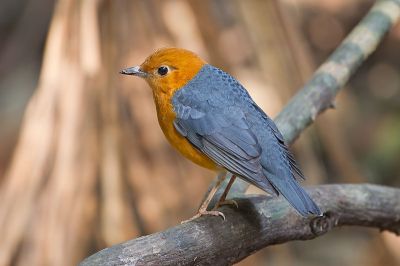Then He answered them, saying, “Which of you, having a donkey or an ox that has fallen into a pit, will not immediately pull him out on the Sabbath day?” (Luke 14:5 NKJV)
This Sunday’s continuation of the Passerines (Songbirds) bring us to two more families, one small with only 2 species of Oxpeckers and the other, the large Thrush family with 167 members.
The oxpeckers are two species of bird which make up the family Buphagidae. Oxpeckers are endemic to the savanna of Sub-Saharan Africa. Both the English and scientific names arise from their habit of perching on large mammals (both wild and domesticated) such as cattle or rhinoceroses, and eating ticks, botfly larvae, and other parasites.
Oxpeckers feed exclusively on the backs of large mammals. Certain species are seemingly preferred, whereas others, like the Lichtenstein’s hartebeest or Topi are generally avoided. Smaller antelope such as lechwe, duikers and reedbuck are also avoided, the smallest regularly used species is the Impala, probably because of the heavy tick load and social nature of that species. In many parts of their range they now feed on cattle, but avoid camels. They feed on ectoparasites, particularly ticks, as well as insects infecting wounds and the flesh and blood of some wounds as well. (Info from Wikipedia)
Thrushes are medium-sized mostly insectivorous or omnivorous birds. The genus, Turdus, is the largest genus of the thrush family, Turdidae.
The Turdus genus has a cosmopolitan distribution, with species in the Americas, Europe, Asia, Africa and Australia. Several species have also colonized some oceanic islands, and two species have been introduced to New Zealand. Some New World species are called robins, the most famous of which is the American robin. Several species are migratory.
They are insectivorous, but most species also eat worms, land snails, and fruit. Many species are permanently resident in warm climes, while others migrate to higher latitudes during summer, often over considerable distances.
Thrushes build cup-shaped nests, sometimes lining them with mud. They lay two to five speckled eggs, sometimes laying two or more clutches per year. Both parents help in raising the young.
The songs of some species, including members of the genera Catharus, Myadestes, and Turdus, are considered to be among the most beautiful in the avian world. (Info from Wikipedia)
“Even the stork in the sky Knows her seasons; And the turtledove and the swift and the thrush Observe the time of their migration; But My people do not know The ordinance of the LORD. (Jeremiah 8:7 NASB)
“I Heard The Bells With Peace On Earth” – with Jessie Padgett, Angel Long and the FX Girls
*
Faith Baptist has just recently started posting our services on YouTube. Here is last Sunday’s Message (Dec 6, 2015) if you would like to watch it. We have a great pastor and church. He is doing a Christmas theme during December.
https://youtu.be/pfnh-2tJ6Wk&rel=0
*
Buphagidae – Oxpeckers Family
Turdidae – Thrushes Family
PASSERIFORMES Order
Birds of the Bible – Bluebirds
*




Oxpeckers and mammals who need them — nice examples of mutualistic symbiosis — friends helping friends! Regarding thrushes, the American Robin is probably my favorite — I saw so many of them in Maryland when I was a boy.
LikeLiked by 1 person
Thanks, Dr. Jim.
LikeLike
How wonderful that the Lord sent the Oxpecker to deparasite the large mammals incapable of removing their attackers! Praise our wonderful Lord!
LikeLiked by 1 person
It’s just like our Lord to provide a meal and a service for those two.
LikeLiked by 1 person
SUPER!
LikeLiked by 1 person